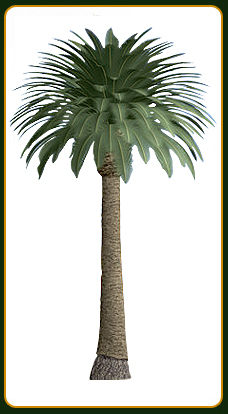Technical Data
Phoenix dactylifera

Scientific or Latin name: Phoenix dactylifera.
Common names: Date Palm, True Date Palm, Tamara.
Family: Arecaceae (previously Palmaceae).
Origin: A native to Northern Africa and West Asia.
Etymology: According to some authors, the genus name is taken from the Greek, as these people saw this plant in Phoenicia for the first time and, according to others, because its leaves reminded them of the feathers of the mythical Phoenix bird. The specific word is made of dactylus = date (dactylos, in Greek) and fero = I carry; that is to say, date carrier.
Main features: The date Palm differs from the Canary Palm (Phoenix canariensis) because it is much taller (25-30 m). Its trunk is smaller. Its leaves have a certain bluish-green tint, the Canary Palm is green. The petioles leave some characteristic marks on the trunk and it grows faster than the canariensis. It is a very imposing palm tree with a very graceful trunk up to 30 m tall ornamentally covered by the remains of its dead leave pods with coriaceae segments, lined, stiff and prickly in whitish green. The leaves, which gather in a maximum number of 20 / 30 and create an apical crown, are pinnate up to 6 m long, the top ones rising and the lower ones curved towards the ground. It has dyadic flowers (each sex in a different tree) which are white and perfumed, on a long pendulum, in a shuck that covers the long cymes. It flowers in springtime. The fruit is a long 2.5 to 8 cm. date yellow or orange in color which later turns into reddish brown with a single very hard bone that has a deep longitudinal slit. The fruit ripens in autumn, a year after the flowering takes place. It starts yielding fruit when it is 12 or 15 years old and does so abundantly until it is 60 to 80 years old. This palm tree has an average lifespan of 250 to 300 years.
Cultivation: The date palm is the fruit species which is most resistant to salinity. Nevertheless, its growth and date quality become poor in very salty soils. It hardly vegetates in compact soils with deficiencies in water elimination.
Light: It requires a warm climate, plenty of sun and a not-too-dry soil.
Temperaturas: It can stand frost down to -10ºC. Under a temperature of -4ºC the leaves start to get frostbitten.
Soil:It adapts to a wide range of climates. It is ideal for coastal avenues as it is not affected by winds or salty water. It resists watery soils for more than 2 months.
Watering: It has an excellent resistance to droughts, no wonder it grows in the desert.
Transplanting: Contrary to the canariensis, date palms are very resilient when transplanted. They even tolerate being transplanted with naked roots; this is not advisable; it should be done with a ball of earth.
Multiplication: Propagation is made by seed or seedlings. In commercial plantations, most trees are females but a few male trees are necessary for their polinization. The plants obtained from seed produce the same number of male and female palm trees, of which only the latter are valuable from a production point of view. The female palm trees born from seed yield a variable quality of fruit, generally of low quality, so that commercial growers have little interest in them and prefer superior clone varieties even though these have to reproduce vegetatively by seedlings. Date seeds germinate easily.